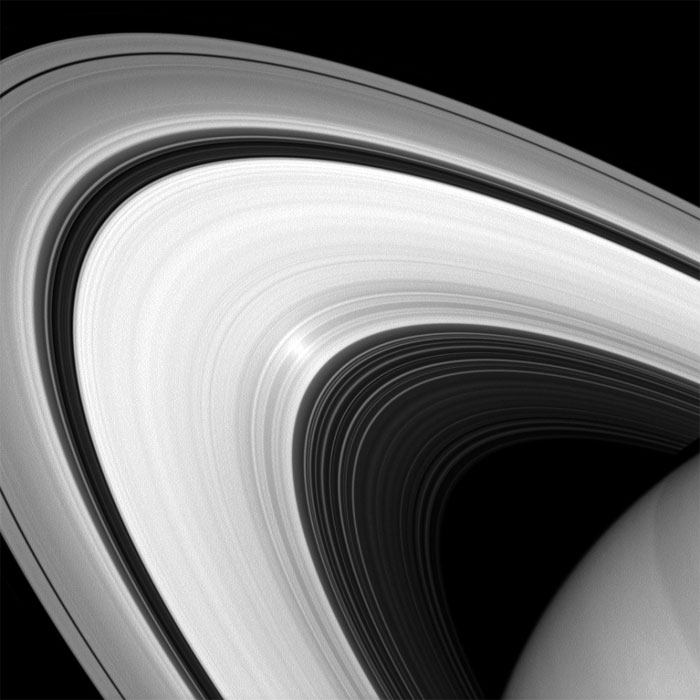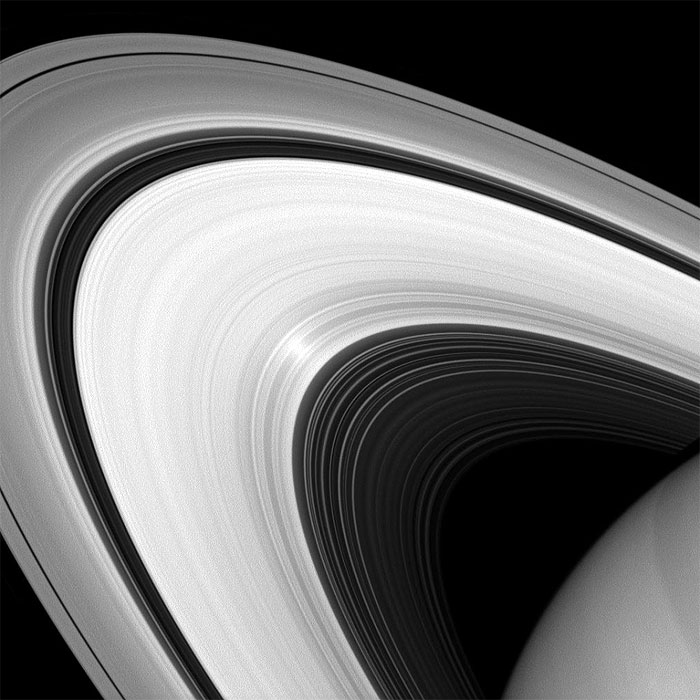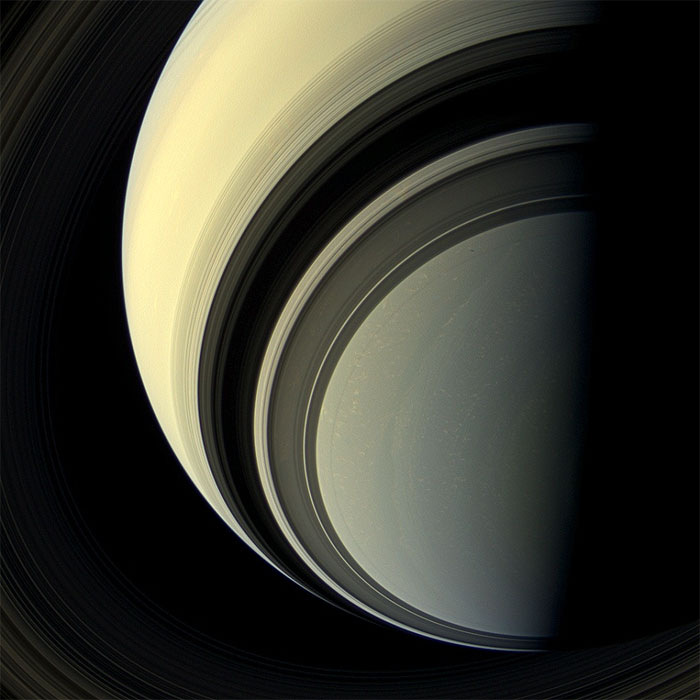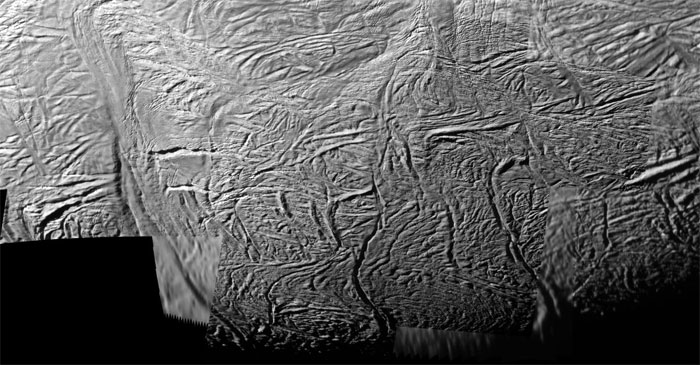.

Round and Round
.
Just as Saturn's famous hexagonal shaped jet stream encircles the planet's north pole, the rings encircle the planet, as seen from Cassini's position high above. Around and around everything goes!
This view looks toward the sunlit side of the rings from about 43 degrees above the ringplane. The image was taken with the Cassini spacecraft wide-angle camera on Nov. 23, 2013 using a spectral filter that preferentially admits wavelengths of near-infrared light centered at 752 nanometers.
The view was obtained at a distance of approximately 1.6 million miles (2.5 million kilometers) from Saturn and at a Sun-Saturn-spacecraft, or phase, angle of 97 degrees. Image scale is 93 miles (150 kilometers) per pixel.
The Cassini-Huygens mission is a cooperative project of NASA, the European Space Agency and the Italian Space Agency. The Jet Propulsion Laboratory, a division of the California Institute of Technology in Pasadena, manages the mission for NASA's Science Mission Directorate, Washington, D.C. The Cassini orbiter and its two onboard cameras were designed, developed and assembled at JPL. The imaging operations center is based at the Space Science Institute in Boulder, Colo.
.

Polarized Surge
.
Although it may look to our eyes like other images of the rings, this infrared image of Saturn's rings was taken with a special filter that will only admit light polarized in one direction. Scientists can use these images to learn more about the nature of the particles that make up Saturn's rings.
The bright spot in the rings is the "opposition surge" where the Sun-Ring-Spacecraft angle passes through zero degrees. Ring scientists can also use the size and magnitude of this bright spot to learn more about the surface properties of the ring particles.
This view looks toward the sunlit side of the rings from about 19 degrees above the ringplane. The image was taken with the Cassini spacecraft wide-angle camera on Aug. 18, 2013 using a spectral filter sensitive to wavelengths of near-infrared light centered at 705 nanometers.
The view was acquired at a distance of approximately 712,000 miles (1.1 million kilometers) from Saturn and at a Sun-rings-spacecraft, or phase, angle of 7 degrees. Image scale is 43 miles (68 kilometers) per pixel.
The Cassini-Huygens mission is a cooperative project of NASA, the European Space Agency and the Italian Space Agency. The Jet Propulsion Laboratory, a division of the California Institute of Technology in Pasadena, manages the mission for NASA's Science Mission Directorate, Washington, D.C. The Cassini orbiter and its two onboard cameras were designed, developed and assembled at JPL. The imaging operations center is based at the Space Science Institute in Boulder, Colo.
.

Infrared Image of Saturn's Rings
.
Although it may look to our eyes like other images of the rings, this infrared image of Saturn's rings was taken with a special filter that will only admit light polarized in one direction. Scientists can use these images to learn more about the nature of the particles that make up Saturn's rings.
The bright spot in the rings is the "opposition surge" where the Sun-Ring-Spacecraft angle passes through zero degrees. Ring scientists can also use the size and magnitude of this bright spot to learn more about the surface properties of the ring particles.
This view looks toward the sunlit side of the rings from about 19 degrees above the ringplane. The image was taken with the Cassini spacecraft wide-angle camera on Aug. 18, 2013 using a spectral filter sensitive to wavelengths of near-infrared light centered at 705 nanometers.
The view was acquired at a distance of approximately 712,000 miles (1.1 million kilometers) from Saturn and at a Sun-rings-spacecraft, or phase, angle of 7 degrees. Image scale is 43 miles (68 kilometers) per pixel.
.

Tis the Season
.
Winter is approaching in the southern hemisphere of Saturn and with this cold season has come the familiar blue hue that was present in the northern winter hemisphere at the start of NASA's Cassini mission. The changing blue hue that we have learned marks winter at Saturn is likely due to reduction of ultraviolet sunlight and the haze it produces, making the atmosphere clearer and increasing the opportunity for Rayleigh scattering (scattering by molecules and smaller particles) and methane absorption: both processes make the atmosphere blue. The small black dot seen to the right and up from image center, within the ring shadows of the A and F rings, is the shadow of the moon, Prometheus.
This view looks toward the unilluminated side of the rings from about 44 degrees below the ring plane. Images taken using red, green and blue spectral filters were combined to create this natural color view. The images were taken with the Cassini spacecraft wide-angle camera on July 29, 2013.
This view was acquired at a distance of approximately 1.003 million miles (1.615 million kilometers) from Saturn. Image scale is 58 miles (93 kilometers) per pixel.
.

Frozen in Time
.

NASA's Cassini captures a still and partially sunlit Enceladus. The Saturnian moon is covered in ice that reflects sunlight similar to freshly fallen snow, making Enceladus one of the most reflective objects in the solar system. The blue color in this false-color image indicates larger-than-average ice particles. The moon's surface is decorated with fractures, folds and ridges caused by tectonic stresses.
This view looks toward the side of Enceladus (313 miles or 504 kilometers across) that faces backward in the moon's orbit around Saturn. North on Enceladus is up. The images were taken with the Cassini spacecraft narrow-angle camera on April 7, 2010, using filters sensitive to ultraviolet, visible and infrared light (spanning wavelengths from 338 to 750 nanometers).
The view was acquired at a distance of approximately 123,000 miles (198,000 kilometers) from Enceladus. Image scale is 3,889 feet (1 kilometer) per pixel.
.
Quelle: NASA
5643 Views
